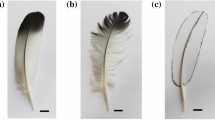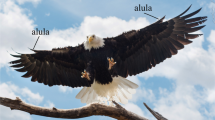Abstract
Primary feathers of soaring land birds have evolved into highly specialized flight feathers characterized by morphological improvements affecting aerodynamic performance. The foremost feathers in the cascade have to bear high lift-loading with a strong bending during soaring flight. A challenge to the study of feather aerodynamics is to understand how the observed low drag and high lift values in the Reynolds (Re) regime from 1.0 to 2.0E4 can be achieved. Computed micro-tomography images show that the feather responds to high lift-loading with an increasing nose-droop and profile-camber. Wind-tunnel tests conducted with the foremost primary feather of a White Stork (Ciconia ciconia) at Re = 1.8E4 indicated a surprisingly high maximum lift coefficient of 1.5 and a glide ratio of nearly 10. We present evidence that this is due to morphologic characteristics formed by the cristae dorsales as well as air-permeable arrays along the rhachis. Measurements of lift and drag forces with open and closed pores confirmed the efficiency of this mechanism. Porous structures facilitate a blow out, comparable to technical blow-hole turbulators for sailplanes and low speed turbine-blades. From our findings, we conclude that the mechanism has evolved in order to affect the boundary layer and to reduce aerodynamic drag of the feather.











Similar content being viewed by others
Abbreviations
- A L :
-
Lifting area (m2)
- AR:
-
Aspect ratio (AR = b 2 /A L)
- b :
-
Wingspan (m)
- c :
-
Profile chord (m)
- C D :
-
Total drag coefficient
- C Lmax :
-
Lift coefficient at maximum lift
- CL/CD:
-
Glide ratio (L/D)
- d/c:
-
Profile thickness related to c
- D :
-
Drag force (N)
- f/c:
-
Profile camber related to c
- L max :
-
Maximum lift-force (N)
- P :
-
Static pressure (N/m2)
- P D :
-
Drag power (W)
- P S :
-
Dissipation power (W)
- q :
-
Dynamic pressure (N/m2)
- Re :
-
Reynolds Number (Re = V·c/ν)
- V :
-
Volume (m3)
- V :
-
Forward velocity (m/s)
- VRs :
-
Specific volume-rate or permeability (m3/(s N))
- V ∞ :
-
Free stream velocity (m/s)
- \( \rho \) :
-
Standard air density 1.22 (kg/m3)
- ν :
-
Dynamic viscosity (m2/s)
- I :
-
ΔPD/PS (efficiency factor)
References
Altshuler DL, Dudley R, Ellington CP (2004) Aerodynamic forces of revolving hummingbird wings and wing models. J Zool Lond 264:327–332
Carmichael BH (1978) A significant increase in lift to drag ratio of airfoils at low Reynolds number through the use of multiple trippers and low drag laminar flow. In: Annual report of the national free flight society, symposium 1978, vol 11, pp 14–20
Carmichael BH (1981) Low Reynolds number airfoil survey. NASA Contractor Report 165803
Cone CD Jr (1962) The theory of induced lift and minimum induced drag of non-planar lifting systems. NASA Tech Report R-139
Engelke K, Karolczak M, Lutz A, Schaller S, Kalender W (1999) Mikro-CT. Technologie und Applikationen zur Erfassung von Knochenarchitektur. Der Radiologe 39:2003–2012
Herzog K (1968) Anatomie und Flugbiologie der Vögel. Gustav Fischer Verlag, Stuttgart
Heyson HH, Riebe GD, Fulton CL (1977) Theoretical parametric study of the relative advantages of winglets and wing tip extensions. NASA Tech Paper 1020
Hoerner SF (1965) Fluid-dynamic lift, 2nd edn. L. Hoerner, Bricktown
Horeni B, Lnenicka J (1974) Aerodynamika opradvu modelarska. Modelar 4, 5, 6
Horstmann KH, Quast A (1982) Profilwiderstandsverringerung durch Ausblasen. Aerorevue 82:60–63
Hummel D (1980) The aerodynamic characteristics of slotted wing tips in soaring birds. Acta XVII Congressus Internationalis. Ornithologici, vol 1, pp 391–396
Küppers U (1983) Randwirbelteilung durch aufgefächerte Flügelenden. VDI-Fortschrittsbericht R7 Nr. 81, ISBN 3-18-148107-6, VDI-Verlag, Düsseldorf
Kraemer K (1958) Untersuchung eines Tragflügelprofils im Windkanal bei über und unterkritischen Reynolsdszahlen. Forschungsbericht 58-01 der Aerodynamischen Versuchsanstalt Göttingen (AVA)
Kraemer K (1959) Flügelprofile im kritischen Reynoldszahlenbereich. Forschungsbericht 57-A-07 der Aerodynamischen Versuchsanstalt Göttingen (AVA)
Marchaj CA (1979) Aero-hydrodynamics of sailing. Granada Publishing Adlard Coles, St Albans
Müller W, Patone G, Bannasch R, Rechenberg I (1998) Bird flight in unsteady wind conditions. I. Biomechanical properties of birds’ covert feathers. Biona report 13, pp 197–198
Nachtigall W, Kempf B (1971) Vergleichende Untersuchungen zur flugbiologischen Funktion des Daumenfittichs (Alula spuria) bei Vögeln. Z vgl Physiol 71:326–341
Nachtigall W, Wedekind F, Dreher A (1984) Hinweise auf Aerodynamische Rauhigkeitseffekte an Vogelflugprofilen. Biona report 3
Pennycuick CJ (1971) Soaring behaviour and performance of some east African birds, observed from a motor-glider. Ibis 114:178–218
Pfenninger W (1946) Investigations on reductions of friction on wings, in particular by means of boundary layer suction. NACA TM No. 1181
Pfenninger W (1956) Experimental investigation of an airfoil with high lift to drag ratios at low Reynolds numbers. Northrop Aircraft Inc NAI 56-188, Report No. BLC-84
Pressnell MS (1986) The performance of model aircraft gliding in the critical range of Reynolds number 19. In: Annual report of the national free flight society, symposium 1986, pp 33–39
Schlichting H (1964) Grenzschichtheorie. G. Braun, Karlsruhe
Schmitz FW (1960) Aerodynamik des Flugmodells, 4th edn. Carl Lange, Duisburg
Schmitz FW (1953) Messungen betreffend Profil 417a, 417b, AVA Göttingen, Original Document GOAR 3566, Central Library of DLR, Jülich
Selig MS, Donovan JF, Fraser DB (1989) Airfoils at low speeds. Soartech 8. H. A. Stokely, Virginia Beach
Svensson L (1984) Identification guide to European passerines. Rosersberg, Stockholm
Schwetzler D (1987) Widerstandsverbesserung an Modellflugzeugen. Flug- und Modelltechnik 373:31–33
Tucker VA (1993) Gliding birds: reduction of induced drag by wing tip slots between the primary feathers. J Exp Biol 180:285–310
Acknowledgments
We are very grateful for the support from the following institutions: Institute for Medical Physics, University of Erlangen-Nürnberg (Micro-CT-Scans), Institute for Experimental Physics, University of Augsburg (SEM), Institute for Aerodynamics, Technical University of Munich (wind-tunnel tests), Central Library of the DLR (Deutsches Forschungszentrum für Luft und Raumfahrt, Köln). We are also grateful to two reviewers who made valuable suggestions on an earlier version of the manuscript.
Author information
Authors and Affiliations
Corresponding author
Rights and permissions
About this article
Cite this article
Eder, H., Fiedler, W. & Pascoe, X. Air-permeable hole-pattern and nose-droop control improve aerodynamic performance of primary feathers. J Comp Physiol A 197, 109–117 (2011). https://doi.org/10.1007/s00359-010-0592-7
Received:
Revised:
Accepted:
Published:
Issue Date:
DOI: https://doi.org/10.1007/s00359-010-0592-7




